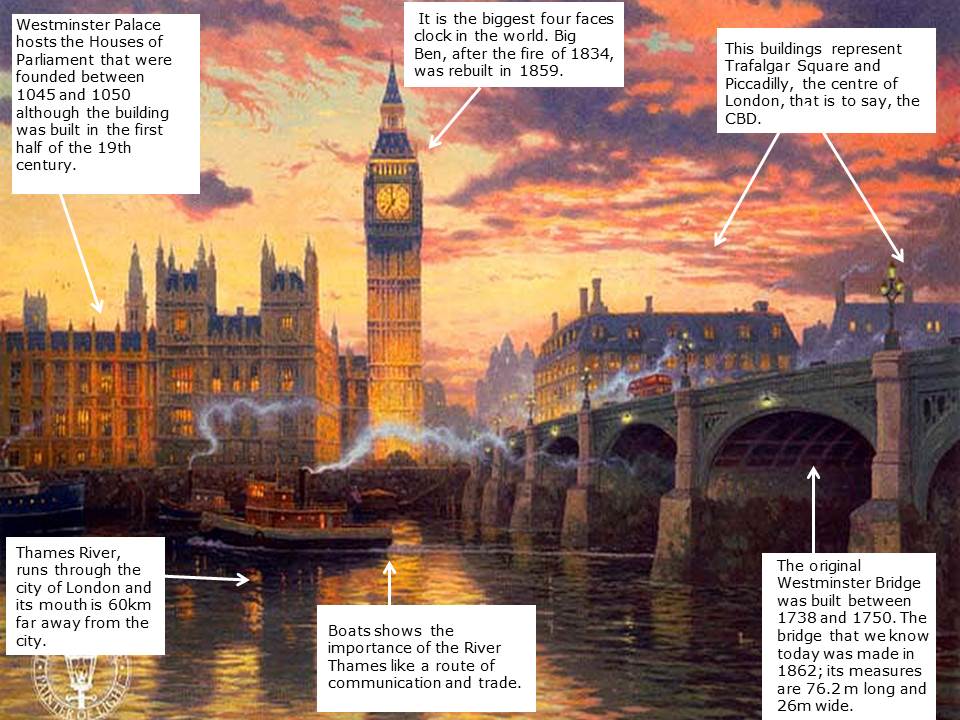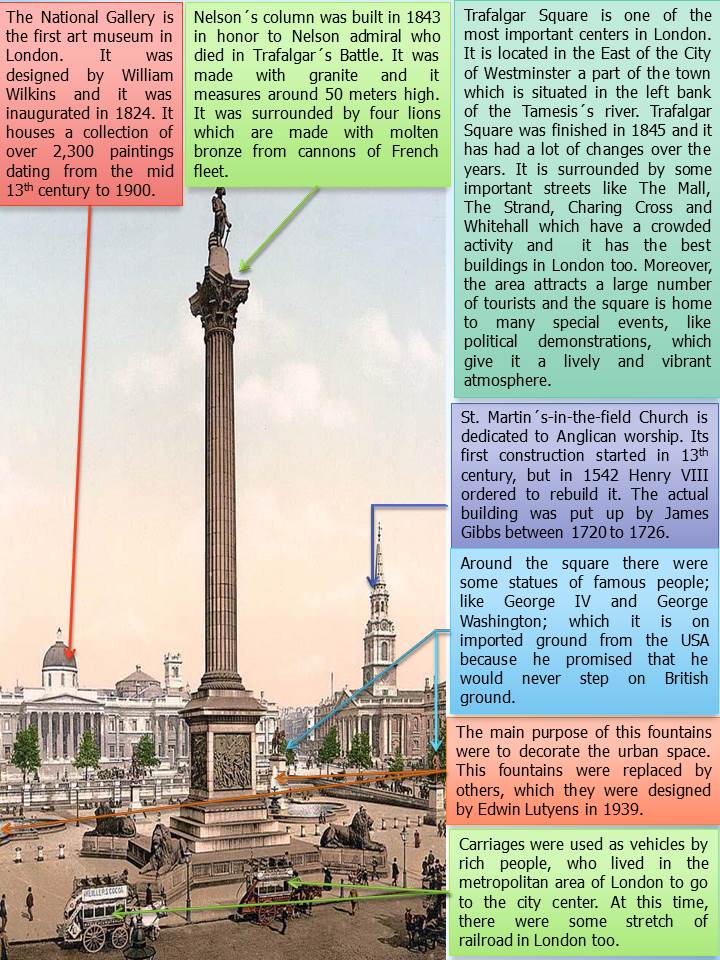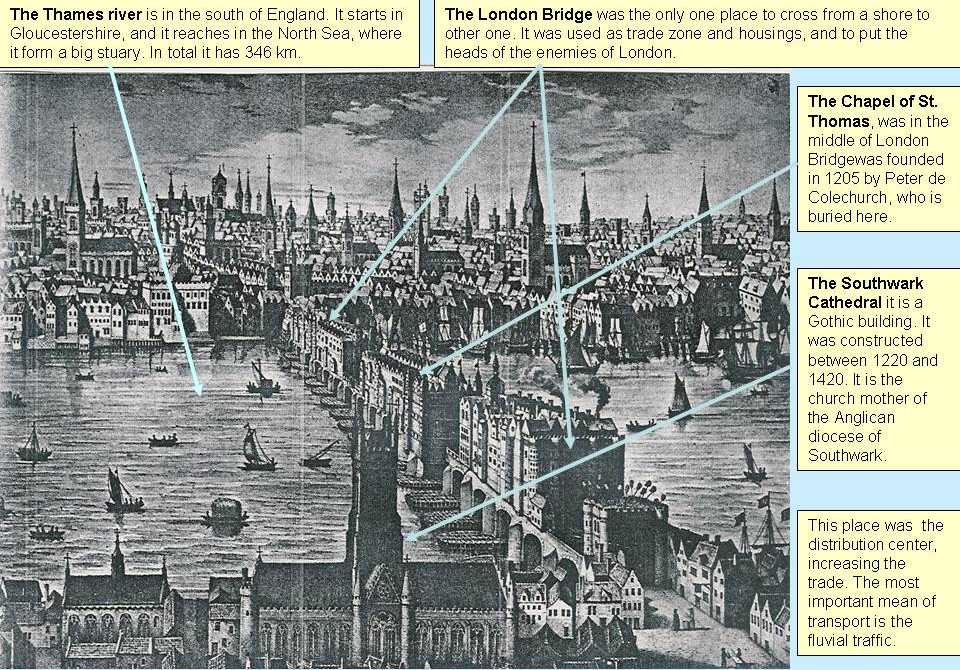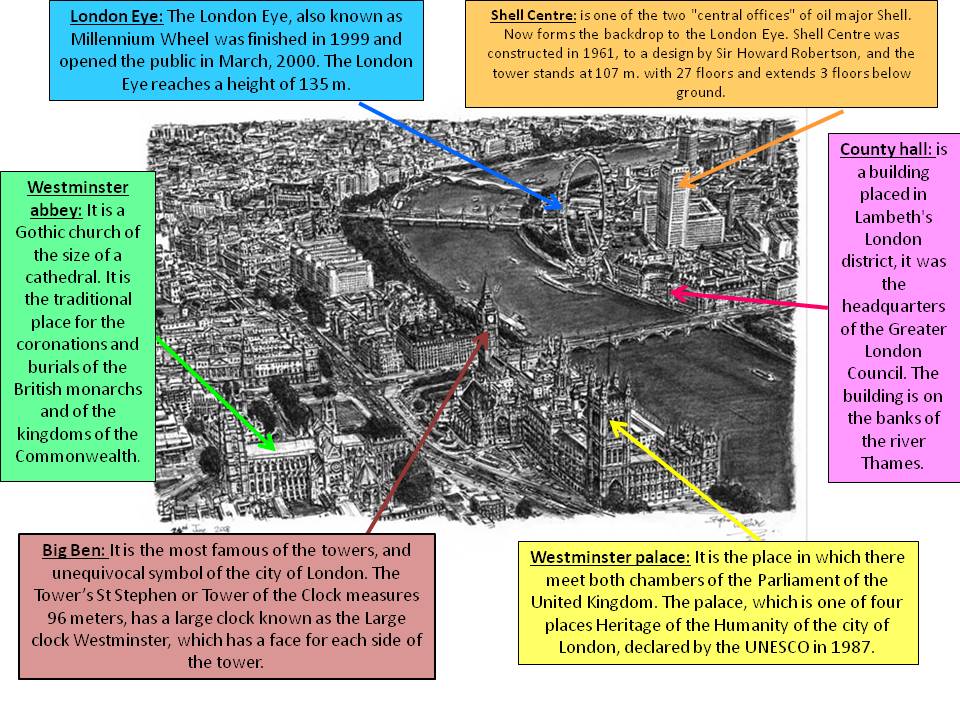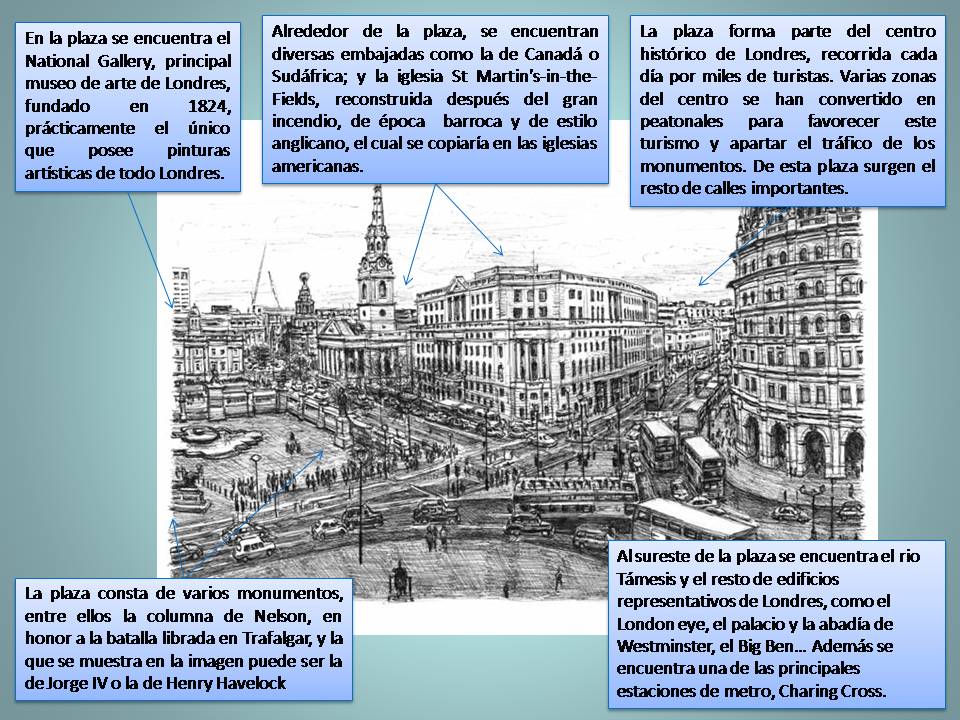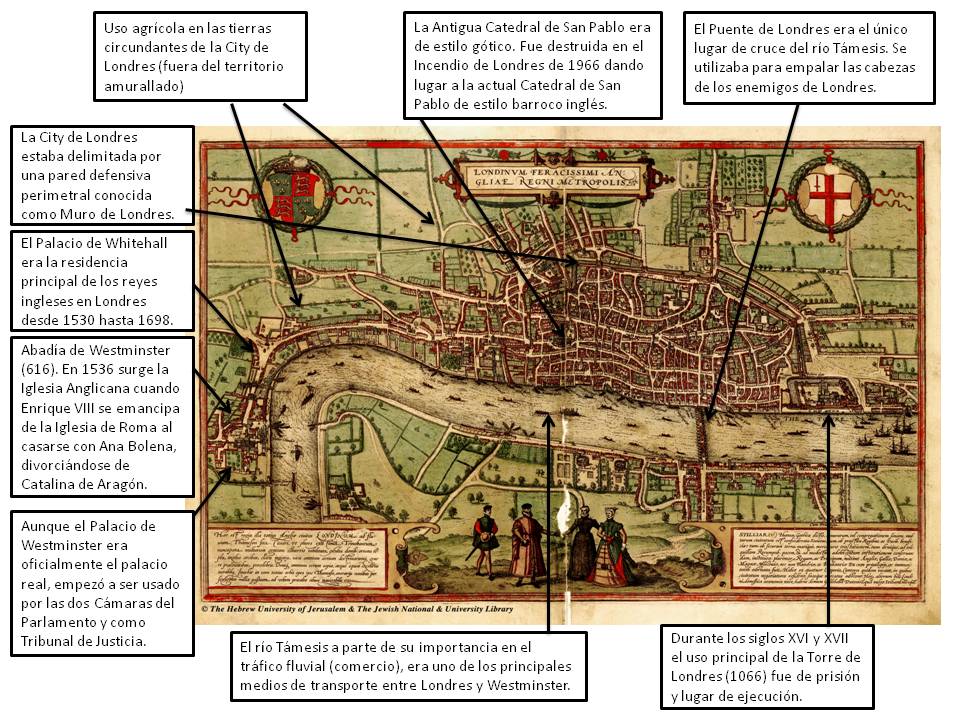LONDRES (Canaletto, 1750)
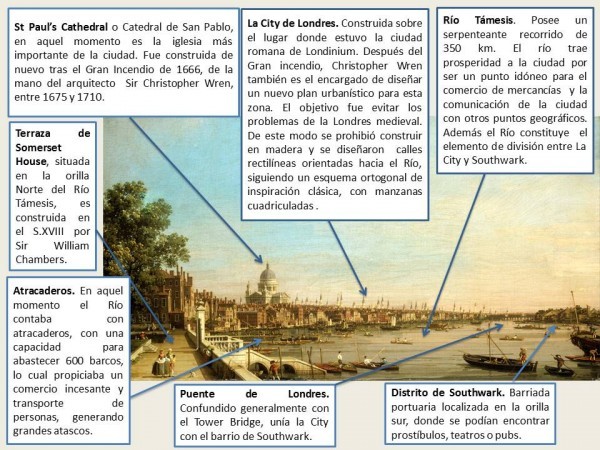
La imagen analizada muestra una de las partes más destacables de la ciudad de Londres (Reino Unido) en el año 1750 (S. XVIII). La obra pertenece a Giovanni Antonio Canal, más conocido como Canaletto (1697- 1768). Este pintor italiano, perteneciente a la corriente veneciana del Barroco, destacó por sus pinturas en las que representaba paisajes urbanos con edificios de la ciudad. Estos edificios aparecen con una gran riqueza cromática y un dibujo minucioso con el que logra un máximo detallismo. Su estilo se caracteriza por el uso de luces y sombras junto con composiciones teatrales. Además utiliza colores cálidos que se relacionan con la fogosidad y el apasionamiento del Barroco. La ciudad más representada en sus obras es Venecia.
En cuanto al contexto histórico de la obra, en esta época Londres posee las características propias de una ciudad georgiana (siglo XVIII), en la que habita una burguesía acomodada y nobleza baja. Durante este periodo Londres experimentó un gran enriquecimiento comercial y cultural. Tras la conquista de la India se desarrolla el comercio y la navegación. Por otro lado, el compositor de la corte, Händel, escribió el Mesías. También, a finales de este siglo se publica el primer diccionario de la lengua inglesa. Finalmente, la arquitectura sufre un importante desarrollo gracias a arquitectos como John Soane o John Nash.
Respecto a la situación y emplazamiento de la ciudad, Londres está ubicada al sur de Inglaterra. Esta privilegiada situación al suroeste del país la ha beneficiado desde sus orígenes siendo la región más poblada y rica del Reino Unido. Respecto al plano urbano de Londres, conserva distinta estructuras correspondientes a las distintas fases de asentamiento. La City de Londres está situada sobre la antigua ciudad romana que contaba con una muralla. Durante la Edad Media este distrito posee una estructura irregular con los edificios apiñados sobre el plano. Esta región de Londres ha sido arrasada hasta tres veces a lo largo de la historia. En el año 1212 este distrito de Londres es arrasado por un incendio. Unos siglos más tarde esta región es reducida a cenizas de nuevo por el famoso Gran Incendio de Londres, en el año 1666.
El arquitecto Christopher Wren fue el encargado de diseñar un nuevo plan urbanístico para la zona. De este modo, todos los edificios de La City, que eran de madera, tuvieron que ser reconstruidos incluyendo la Catedral de San Pablo de la cual se hablará a continuación. El proyecto seguía una forma ortogonal de inspiración clásica, incluyendo ejes dominantes que proporcionan dinamismo barroco. Los grandes ejes están constituidos por grandes avenidas diagonales, con el objetivo de acortar distancias y hacer destacables edificios emblemáticos como las iglesias, muchas de las cuales observamos en la imagen, grandes plazas con monumentos, palacios o museos. Este modelo urbano será imitado durante la época del Neoclasicismo en algunas ciudades nuevas de EE.UU como Nueva York o Washington.
A parte de La City, Londres está compuesto por 32 municipios (London Boroughs). Cada uno de ellos se caracteriza por ofrecer distintos servicios y actividades. Chinatown y Soho son los dos barrios más multirraciales, siendo el lugar donde se desarrolla la vida nocturna de la ciudad. En ellos encontramos desde restaurantes, bares de moda o lujosas boutiques. En el caso de Westminster y Whitehall, las actividades más comunes son de carácter turístico ya que poseen una importante carga histórica. Además, es importante citar que desde los tiempos de Eduardo el Confesor, Westminster ha sido sede del Gobierno Británico. Finalmente, destaca Covent Garden y The Strand, en los cuales encontramos famosos mercados callejeros pero también restaurantes, pubs y cafés.
Los principales elementos urbanos observados en la imagen, son la Catedral de San Pablo, el distrito de la City de Londres, la terraza de Somerset House, el puente de Londres, los atracaderos y las barcas en el Río Támesis y la orilla sur en la que se localiza el distrito de Southwark.
La Catedral de San Pablo que retrata Canaletto es la perteneciente a la época de la reconstrucción de La City después del Gran incendio de Londres. Esta nueva catedral es construida entre 1675 y 1710 de la mano del prestigioso arquitecto Cristopher Wren. Edificada en el estilo Barroco inglés, cuenta con una gran cúpula que destaca en el horizonte de Londres desde su aparición. Además, La Somerset House, de la cual se aprecia su terraza, también pertenece a este periodo de reconstrucción. De nuevo Cristopher Wren fue el encargado de diseñar este importante edificio de Londres, que albergaba oficinas gubernamentales, sociedades científicas y la sociedad naval. Por otro lado, los atracaderos del Río Támesis en aquella época estaban algo obsoletos, contando tan solo con 600 de ellos, se formaban grandes atascos de barcas para descargar las mercancías. En muchas ocasiones las barcas tenían que ser amarradas y con frecuencia la mercancía que contenían era robada para el contrabando. Para solventar este problema, Londres crea la primera policía fluvial que continua vigente hoy en día. En cuanto al puente de Londres, es frecuentemente confundido con el Tower Bridge. En el lugar donde se encuentra, lleva existiendo un puente desde la época romana. Finalmente, Southwark era una barriada portuaria situada en la orilla sur del Río Támesis. Este distrito era frecuentado por maleantes puesto que muchas actividades ilegales se desarrollaban en esta zona.
Por último se describen cuáles eran los principales aspectos sociales y culturales de la ciudad junto con las actividades económicas desarrolladas en Londres a mediados del siglo XVIII. La llegada de la Revolución Industrial hace que muchas de las actividades desarrolladas en Londres estén directamente relacionadas con la industria. Tras la invención de la máquina de vapor en 1705 se consolidara la hegemonía naval del país. Además surge la clase media londinense. Destaca la publicación de uno de los libros más importantes en el ámbito económico, La Riqueza de las Naciones, escrito por Adam Smith, en la cual está basado el capitalismo moderno. También se comienzan a publicar las primeras novelas modernas en inglés. Sin embargo, parte de la economía de este periodo es de carácter clandestino. Existe un alto nivel de economía sumergida como consecuencia del contrabando de mercancías, pillaje y prostitución. Finalmente, es importante destacar que en este siglo se crea el Reino de Gran Bretaña, tras un acuerdo con el Reino de Gales y el Reino de Escocia, algo que convertirá a la ciudad de Londres en el punto más importante del Reino.
Mercedes Pascual de Luis

